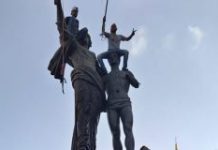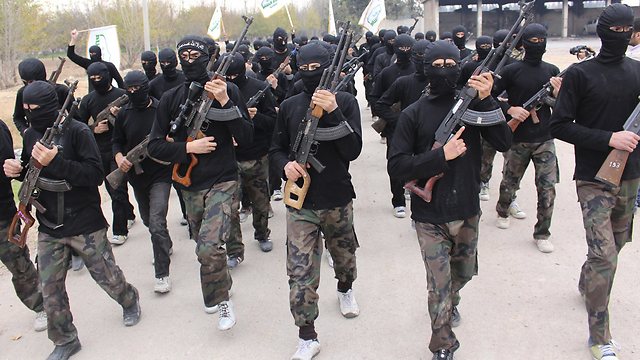Assad and ISIL Can Make the Political Solution in Syria Obsolete
Samir Altaqi/Esam Aziz/Middle East Briefing/August 15/15
The current picture in Syria looks as follows: An effort to alter the balance of power on the ground is coupled with a parallel effort to unclog the pipes of contacts in an attempt to reach a multi-party consensus on a political deal. However, when we bring this general picture, with its two parallel lines, to earth and try to fit it on what is really happening in Syria we discover immediately that the dress does not fit. There are many sources of complications. The immediate, and most important, are two: Assad and ISIL. Let us see the way they both try separately to derail the two parallel lines we just mentioned. When the Russians blamed the Saudis for blocking any political solution, Deputy Crown Prince Muhammad ben Salman assured President Putin that Saudi Arabia is ready to go the extra mile to find a political solution. Putin asked “even meeting with Syrian officials?. The answer was “Yes, provided that your country will be present in the meeting”.
It was arranged after the meeting that Syria’s Chief of intelligence Ali Mamlouk and a Russian delegation headed by Russia’s Deputy Foreign Minister Mikhail Bogdanov would go separately to Saudi Arabia and have a trilateral meeting. The meeting took place at the end of July. The Saudi side of the story tells us that Mamlouk asked the Saudis to stop aiding the opposition. The Saudis said they will do that only if Iran and Hezbollah stop aiding the regime. Damascus refused the Saudi proposition and the meeting was declared a total failure. But what was striking is that Assad leaked the news of the meeting in two steps. The first was to ask permission for Memlouk’s private plane to land in Kuwait on its way to Jeddah, which is taken as an alert to the GCC that Riyadh is negotiating with Damascus without prior coordination with its closest allies. The second was passing a report in a pro-Syria Lebanese newspaper which included what the Saudis consider a distortion of what happened in their meeting with Mamlouk. The Syrian side of the story is that Riyadh understands that the problem of terrorism is a two edged sword and that it ready to negotiate with Assad.
One of the valid explanation to why Assad decided to leak the news of the meeting is that he understands that the diplomatic track may ultimately cost him his chair. He believes that Syria is heading to be either divided into two, the Western Alawi enclave in one side and the rest of Syria in the other. Or that a gradual change in the balance of power coupled with diplomatic efforts can force him to cede power and allow the birth of a new Syria, unified in a way or another where he and his gang have no place. This second scenario is the one that Assad resisted all along. If he and his Iranian allies cannot keep the chair of the President of all of Syria, their Plan B is to go west and establish a pro-Iranian mini state. However, Assad fears one thing: It is that Iran would sell him off if negotiations gave it some of the strategic objectives it badly wants, mainly a corridor to Hezbollah.
This fear in the minds of senior Syrian officials is actually a minor one. The feared scenario is not likely. Yet, it is there. At one point or another, and under pressure from the Syrian people, the opposition and the international community, the relevant parties may accept a deal at the expense of Syria’s ruling Mafia. Indeed, the Iranians have a different take. They do not look at Assad from any personal angle. They look at Syria from the perspective of protecting Hezbollah. They understand that Assad, as the President of all of Syria, is a dead man walking. But they still inflate his role as a scarecrow to maximize the weight of their bargaining chip if it boils down to negotiating or to organize the withdrawal to the west in case Syria becomes two Syrias.
The Iranian left their ultimate options opened. If a united Syria based on a Taif-like deal emerges, and if this deal guarantees their interests, be it. If not, then a western enclave headed by Assad.
As it is now, the most likely option is ultimately partitioning Syria. In hedging his bets, Assad prefers to see a long term fight between ISIL and non-ISIL forces in the rest of Syria. That will give him some time to breath in his western enclave and may even lead to international intervention. At that point in time he would have a chance to pull a deal that is better than remaining in his western pocket, waiting for the Sunnis to attack him and his forces and unify their country again.
The Russian attempt to unclog channels has reached an impasse when the Saudis refused Moscow’s plan of collective cooperation, even with Assad, to confront terrorism.
Simply put, Assad has a clear tactical benefit in ISIL expanding its presence at this critical moment. It will delay any attacks on the west, it will complicate any diplomatic solution that is done at the expense of his head and it will turn the non-Assad Syria into hell. Neither Iran nor Assad have reached a strategic decision to accept anything close to what the opposition wants, which is a unified Syria under the control of one government. Therefore, they both will fight to improve terms on the ground in case of negotiations or to secure the strategic areas vital to the future Syrian enclave and Hezbollah. ISIL does not welcome the diplomatic talks neither, But in the case of the organization, and as it understands that things are moving towards a change in the balance of power, it decided to work on the ground to block any potential deal.
It is clear therefore that Assad calculus is the first “curve” that makes the dress unfit to the body, or that makes implementing the two parallel lines mentioned above inapplicable on the ground.
ISIL is the second undesired “curve”. In an important strategic development ISIL was able to connect its area of control in East Qalamoun with Syria’s eastern desert. Currently the organization is preparing to cut the Damascus-Homs highway and potentially rush to Damascus from north to capture it before the “Western Front” gets it. ISIL’s capture of Al Qariyatain, south of Homs is so important to the extent that it is seen as a game changer. One of the important significance of this step is that it targets the “Strategic Triangle” where the Syrian Army stores most of its strategic weapons. Rockets, chemical warheads, relatively advance munition and many sophisticated military equipment is stored in this triangle. The triangle defined by the power station which is roughly 20 miles south of Homs, the village of Hassaia and the village of Qara. This is where the legendry Division 18 is stationed. In other words, this triangle, now targeted by ISIL, is the center of Syria’s strategic forces.
ISIL also is advancing in the north of Aleppo as well. It just surprised the opposition with a swift attack that ended with controlling the strategic village of Om Hosh. It is targeting the Syrian army Infantry College. And it is focused on Assad forces air base in Kwaires. If it is to capture these strategic points, it will be able to cut Aleppo from the north, a step that will certainly disrupt opposition plans to take Aleppo and leave Turkey with one of two options: either to fight ISIL even beyond Ankara’s buffer zone or talk again to the terrorist organization. ISIL is also trying to reactivate its southern front through its allies in Lewa Al Yarmouk. Yet, the opposition forces are achieving progress towards Daraa which can fall any time. The reason of reactivating its southern operation is that ISIL wants to stall the opposition advance towards Damascus. ISIL’s view is that any flag other than its black one is an enemy flag and it should not be raised, particularly on Damascus due to its political significance.
The structural contradiction in Assad-Iran objectives is that if they welcome ISIL advances from the point of view of protecting the west by pushing everybody to fight everybody else, this will abort any Taif deal. In other words, the tactical steps taken now do not necessarily facilitate the objective. Unless if the objective is only implementing Plan B, that is the withdrawal to the west.
Assad-Iran gambit is indeed very risky. One scenario shows that clearly. If ISIL becomes a dominant force in all of Syria (except the west), who will be able to stop it from creeping to the west? This gambit may lead to international intervention where UN forces protect the western enclave. There is an assumption in Washington and other Western capitals that the situation can be managed if Assad withdraws to the west and the opposition takes the rest. This assumption is illogical. It simply reduces the role of ISIL to less than what could be realistic. It also neglects the dynamics within the Syrian opposition based on the false proposition that this opposition can be fully controlled through regional capitals. This idea errs insofar as it assumes that this control is a constant.
What is clear from this complex picture is that Assad and ISIL are the two obstacles facing the implementation of any concept related to political solutions. Furthermore, a deeper reflection upon the components of the Syrian crisis in their motion, and not frozen in any present moment as is commonly done, reveals that the political solution will be much more difficult in the future than it is at the current configuration.
The one thing that is astounding in this picture is how the Syrian opposition is standing passively when everybody else is busy amputating their own country. The Turks got their buffer zone, the Jordanians and Israelis have already theirs. Assad and the Iranians will go west. And Hezbollah is fighting to secure the area adjacent to his portion of Lebanon. The rest of Syria will be left to the Syrian opposition to kill each other and for the Syrian people to continue bleeding. The opposition hears the voices of quarters very far from the killing fields, yet they do not seems to hear the calls of their homeland, neither the noise of knives partitioning their country.
Iraq and the Question of the Nation State in the Middle East
Samir Altaqi/Esam Aziz/Middle East Briefing/August 15/15






















